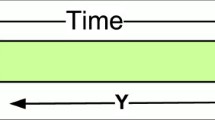Abstract
This article investigates the queueing system of the primary user (PU) in a spectrum-sharing cognitive environment when the cognitive transmission satisfies the PU’s outage probability constraint. The primary queueing model is investigated under a cooperative cognitive scheme as well. The performance measures are compared to those in a Rayleigh channel. Because of the random channel outages, an \(M/G/1\) model is found appropriate to describe the PU’s queueing system even though the PU transmits its data at a constant rate. The queueing performance measures are investigated; these measures include mean service time, server utilization, mean waiting and transit times, and mean number of waiting and transit packets. Numerical results are provided to illustrate the PU’s queue measures under Rayleigh, cognitive, and cooperative cognitive modes.







Similar content being viewed by others
References
Federal commununications commission. Spectrum policy task force report. ET Docket No. 02–135, Nov 2002.
Kang, X., Zhang, R., Liang, Y.-C., & Garg, H. K. (2009, June). Optimal power allocation for cognitive radio under primary user’s outage loss constraint. In IEEE International Conference on Communications (ICC), pp. 1–5.
Li, D. (2010). Performance analysis of uplink cognitive cellular networks with opportunistic scheduling. IEEE Communications Letters, 14, 827–829.
Farraj, A. K., Miller, S. L., & Qaraqe, K. A. (2011, December). Queue performance measures for cognitive radios in spectrum sharing systems. In IEEE Global Telecommunications Conference (GLOBECOM) Workshop, pp. 997–1001.
Farraj, A. K. (2013). Queue model analysis for spectrum-sharing cognitive systems under outage probability constraint. Wireless Personal Communications. doi:10.1007/s11277-013-1245-2.
Goldsmith, A. (2005). Wireless Communications (1st ed.). Cambridge: Cambridge University Press.
Farraj, A. K. (2013). Impact of cognitive communications on the performance of the primary users. Wireless Personal Communications, 71, 975–985.
Tse, D., & Viswanath, P. (2005). Fundamentals of wireless communication (1st ed.). Cambridge: Cambridge University Press.
Bolch, G., Greiner, S., de Meer, H., & Trivedi, K. S. (2006). Queueing networks and Markov chains: Modeling and performance evaluation with computer science applications (2nd ed.). London: Wiley.
Miller, S. L., & Childers, D. G. (2004). Probability and random processes: With applications to signal processing and communications (1st ed.). Amsterdam: Elsevier.
Adan, I., & Resing, J. (2001). Queueing theory. Available at http://www.cs.duke.edu/fishhai/misc/queue.pdf.
Little, J. D. C. (1961). A proof of the queuing formula: \(L = \lambda W\). Operations Research, 9, 383–387.
Author information
Authors and Affiliations
Corresponding author
Rights and permissions
About this article
Cite this article
Farraj, A.K. Analysis of Primary Users’ Queueing Behavior in a Spectrum-Sharing Cognitive Environment. Wireless Pers Commun 75, 1283–1293 (2014). https://doi.org/10.1007/s11277-013-1423-2
Published:
Issue Date:
DOI: https://doi.org/10.1007/s11277-013-1423-2




